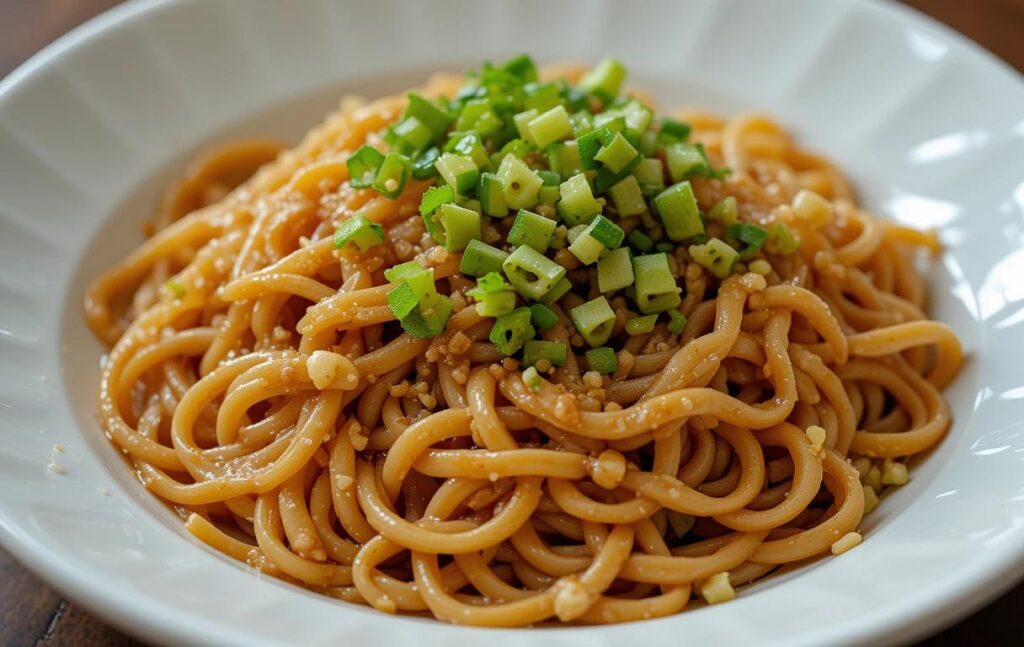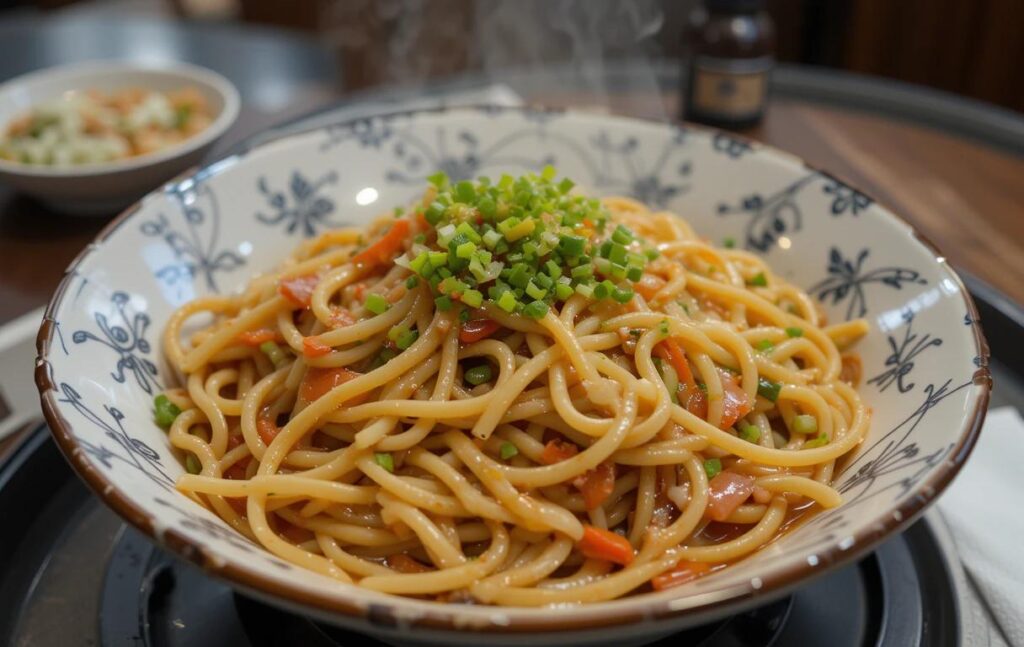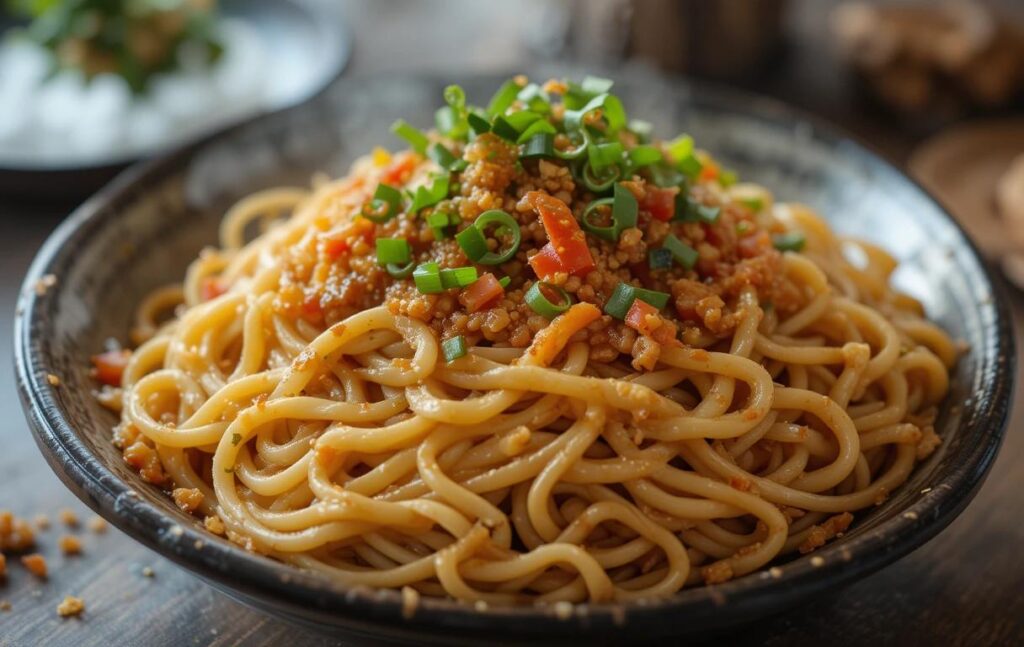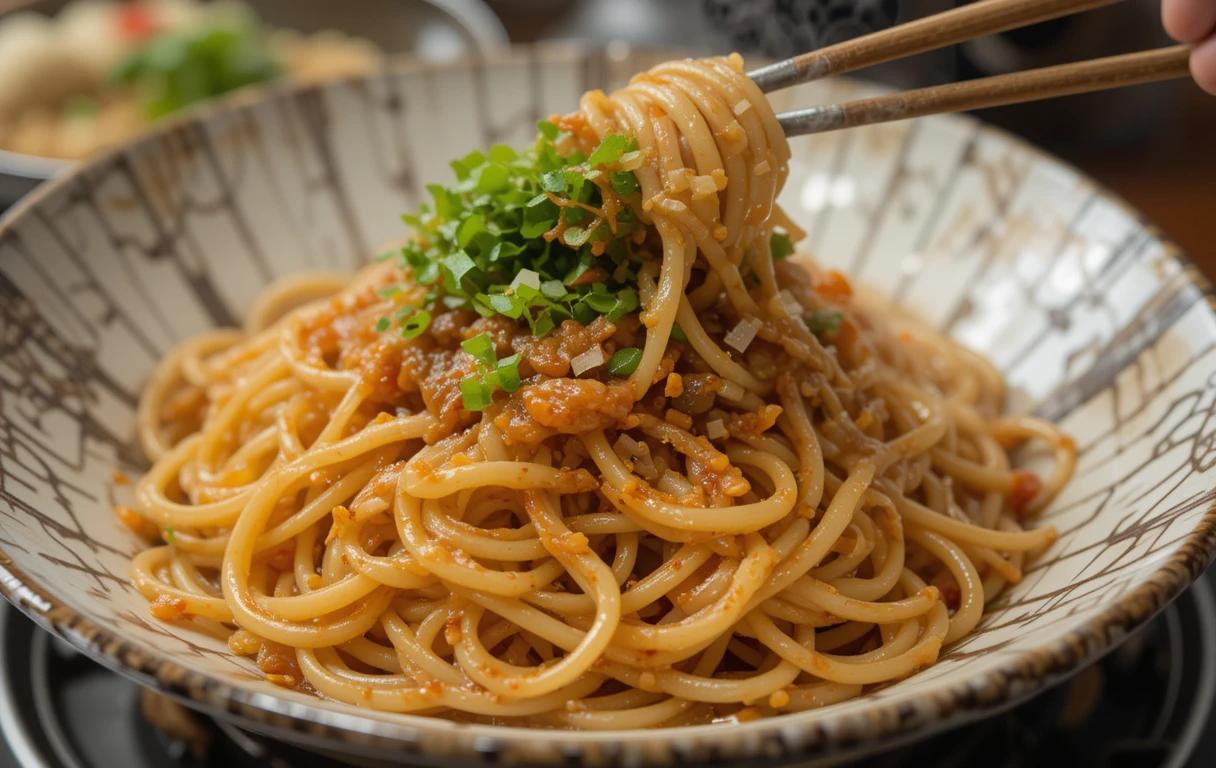Introduction to Hibachi Noodles
Hibachi noodles are a popular dish rooted in Japanese-inspired cuisine, often served at hibachi-style restaurants where chefs prepare meals on a flat-top grill in front of diners. Known for their savory flavor and simplicity, hibachi noodles are stir-fried and seasoned to perfection, making them a delightful accompaniment to grilled meats, seafood, and vegetables.
The noodles are typically made from wheat and resemble lo mein or yakisoba noodles in texture. They are cooked with a combination of soy sauce, garlic, butter, and sometimes sesame oil, which creates their rich and umami-packed flavor profile. Some variations include the addition of vegetables like carrots, onions, and bell peppers, or proteins like chicken, shrimp, or beef, making them a versatile dish.
Hibachi noodles are not just about flavor—they also embody the artistry and entertainment of hibachi-style cooking. The preparation process is a spectacle in itself, with chefs showcasing their culinary skills and engaging diners with impressive knife work, flipping utensils, and even flaming grills.
Perfect for a casual dinner or a special gathering, hibachi noodles have become a beloved comfort food for many, blending Japanese culinary techniques with universal appeal. Whether enjoyed at a restaurant or prepared at home, these noodles are a delightful way to explore the flavors of hibachi cooking.
What Are Hibachi Noodles?
Hibachi noodles are a flavorful and versatile dish commonly found in Japanese-inspired hibachi-style dining. They consist of stir-fried noodles cooked on a flat-top grill, seasoned with a savory blend of soy sauce, garlic, butter, and sesame oil. These noodles are known for their rich umami flavor, smooth texture, and ability to pair seamlessly with a variety of proteins such as chicken, beef, shrimp, or tofu, as well as vegetables.
While they are not traditional to Japanese cuisine in a historical sense, hibachi noodles are a fusion dish that reflects the influence of Western and Japanese culinary techniques. The dish’s appeal lies in its simplicity, quick preparation, and adaptability, making it a favorite among hibachi diners and a common feature in hibachi-style restaurants worldwide.
The Cultural Origins of Hibachi Cooking
Hibachi cooking originates from Japan and refers to the method of grilling food over an open flame or on a high-heat metal grill. The term “hibachi” literally means “fire bowl,” referring to a traditional Japanese heating device that uses charcoal to generate heat. Historically, the hibachi was not used for cooking but as a heat source. Over time, the concept of hibachi cooking evolved, particularly in Western adaptations.
Modern hibachi-style cooking, especially as seen in restaurants, is more accurately described as “teppanyaki,” where chefs prepare food on a flat iron griddle in front of diners. This interactive and theatrical style of cooking became popular in the mid-20th century and spread globally as an entertaining dining experience.
Hibachi cooking celebrates Japanese culinary principles such as balance, fresh ingredients, and meticulous presentation. Though the modern interpretation often incorporates elements from other cuisines, it continues to honor the tradition of showcasing cooking as a craft and a performance, bridging cultures through food and entertainment.
Ingredients for Hibachi Noodles
Essential Components
Hibachi noodles are simple yet flavorful, requiring a handful of key ingredients to achieve their signature taste. The essential components include:
- Noodles: Lo mein, yakisoba, or other wheat-based noodles are commonly used for their ability to hold sauces well and maintain a tender texture.
- Soy Sauce: Provides the salty, umami base for the dish.
- Butter: Adds richness and helps carry the flavors.
- Garlic: Minced garlic enhances the savory profile of the noodles.
- Sesame Oil: Infuses the dish with a nutty aroma and flavor.
- Sugar: A pinch of sugar balances the saltiness of the soy sauce.
- Vegetable Oil: Used for stir-frying and ensuring the noodles don’t stick to the grill or pan.
Common Variations
Hibachi noodles are versatile and can be customized with various ingredients to suit different tastes. Popular variations include:
- Protein Additions:
- Chicken, beef, shrimp, or tofu can be stir-fried with the noodles.
- Vegetables:
- Carrots, onions, bell peppers, and mushrooms add texture and color.
- Seasonings:
- Ginger, chili flakes, or teriyaki sauce can be added for a unique twist.
- Toppings:
- Toasted sesame seeds, chopped green onions, or a drizzle of sriracha for added flair.
Choosing the Right Noodles
Selecting the right noodles is crucial for achieving the authentic hibachi experience. Here are some tips:
- Lo Mein Noodles: These are the most commonly used due to their soft texture and ability to absorb sauce flavors.
- Yakisoba Noodles: A traditional Japanese choice that works well for hibachi dishes.
- Spaghetti: As a substitute, spaghetti can mimic the texture of Asian noodles if prepared al dente.
- Gluten-Free Options: Rice noodles or gluten-free pasta can be used for dietary preferences.
The key is to ensure the noodles are cooked to a firm yet tender consistency (not overcooked) and are able to soak up the flavorful sauces used in hibachi-style cooking.
Step-by-Step Preparation of Hibachi Noodles

Preparing the Ingredients
- Cook the Noodles:
- Start by boiling your chosen noodles (lo mein, yakisoba, or spaghetti) according to the package instructions. Cook them al dente to avoid mushiness.
- Drain the noodles and rinse them under cold water to stop the cooking process, then set aside.
- Chop the Vegetables:
- If using vegetables like onions, carrots, bell peppers, or mushrooms, slice them thinly for quick and even cooking.
- Mince garlic and prepare any additional seasonings, such as grated ginger or chili flakes.
- Prepare the Sauce:
- In a small bowl, mix soy sauce, sesame oil, and a pinch of sugar. For extra flavor, you can add a splash of teriyaki sauce or oyster sauce.
- Gather Protein (Optional):
- If adding chicken, beef, shrimp, or tofu, slice them into bite-sized pieces and season lightly with salt and pepper.
Cooking Techniques
- Heat the Pan or Grill:
- Use a flat-top grill, large skillet, or wok, and preheat it over medium-high heat. Add a mix of vegetable oil and sesame oil to prevent sticking.
- Cook the Protein (Optional):
- If including protein, stir-fry it first until fully cooked, then set it aside.
- Sauté the Vegetables:
- Add your vegetables to the hot pan and stir-fry until slightly tender but still crisp. Push them to the side of the pan to make space for the noodles.
- Stir-Fry the Noodles:
- Add the cooked noodles to the pan and toss them with the vegetables. Pour the prepared sauce over the noodles and mix thoroughly.
- Incorporate the Garlic and Butter:
- Add minced garlic and a generous knob of butter. Stir until the butter melts and evenly coats the noodles, enhancing their richness.
- Combine Everything:
- If using protein, return it to the pan and mix it with the noodles and vegetables. Cook for an additional 2-3 minutes to allow the flavors to meld.
Achieving the Perfect Texture
- Noodles:
- Ensure the noodles are cooked al dente before stir-frying to maintain a firm yet tender texture.
- Toss them gently to prevent breaking during the stir-fry process.
- Vegetables:
- Keep the vegetables slightly crisp for contrast in texture. Avoid overcooking them to preserve their vibrant colors and crunch.
- Sauce Integration:
- Add the sauce gradually and mix well to ensure the noodles are evenly coated without becoming soggy.
- Heat Management:
- Use medium-high heat to create a slight caramelization on the noodles and vegetables, adding depth of flavor.
By following these steps, you’ll achieve restaurant-quality hibachi noodles that are perfectly seasoned, textured, and bursting with flavor.
Hibachi Noodles Sauces
Traditional Sauces
Hibachi noodles rely on a balance of simple, savory ingredients for their classic flavor. Traditional sauces include:
- Soy Sauce: The cornerstone of hibachi sauces, offering a salty and umami base.
- Sesame Oil: Adds a nutty aroma and enhances the overall richness.
- Butter: A key ingredient that contributes creaminess and depth.
- Sugar: A pinch to balance the saltiness and add a subtle sweetness.
These ingredients combine to create the signature hibachi noodle sauce, both flavorful and versatile.
Popular Sauce Variations
To add variety to hibachi noodles, you can experiment with the following popular sauce combinations:
- Teriyaki Sauce:
- A sweet and savory option that adds a caramelized glaze.
- Oyster Sauce:
- Provides a deep, umami-packed flavor perfect for seafood pairings.
- Spicy Soy Sauce:
- Blend soy sauce with sriracha or chili oil for a kick of heat.
- Garlic Butter Sauce:
- Elevates the dish with bold, garlicky richness.
- Yum Yum Sauce (as a side dip):
- A creamy, tangy addition often made with mayonnaise, ketchup, and paprika.
Balancing Flavors
Achieving the perfect sauce balance for hibachi noodles involves:
- Sweetness: Adjust sugar or teriyaki sauce for a hint of sweetness.
- Saltiness: Use low-sodium soy sauce to control the salt levels.
- Acidity: Add a splash of rice vinegar or lemon juice for brightness.
- Heat: Customize spiciness with chili flakes or sriracha.
Taste as you go and adjust each element for a harmonious flavor profile.
Pairing Hibachi Noodles

Best Proteins to Serve With Hibachi Noodles
Hibachi noodles pair wonderfully with a variety of proteins, making them a versatile dish. Popular choices include:
- Chicken: Marinated or grilled chicken complements the savory noodles well.
- Beef: Thinly sliced steak or tenderloin adds richness to the meal.
- Shrimp: Provides a light, seafood twist to the dish.
- Tofu: For a vegetarian option, grilled or pan-fried tofu works perfectly.
- Eggs: A simple scrambled egg can enhance the texture and protein content.
Vegetable Combinations
Adding vegetables not only enhances the dish nutritionally but also provides visual appeal and texture. Great combinations include:
- Onions and Bell Peppers: Sweet and colorful, they balance the savory noodles.
- Carrots and Snap Peas: Add crunch and a subtle sweetness.
- Zucchini and Mushrooms: Earthy and soft, they pair seamlessly with hibachi noodles.
- Broccoli: Blanch and stir-fry for a bright, crisp addition.
Beverage Pairings
Pairing beverages with hibachi noodles enhances the dining experience. Ideal pairings include:
- Green Tea: A traditional Japanese beverage that refreshes the palate.
- Sake: The mild sweetness and smooth finish of sake complement the noodles.
- Japanese Beer: Light and crisp lagers like Sapporo or Asahi balance the rich flavors.
- White Wine: A dry Riesling or Sauvignon Blanc pairs well with soy-based sauces.
- Sparkling Water with Lemon: A non-alcoholic option that cleanses the palate.
By carefully selecting sauces, proteins, vegetables, and beverages, you can create a well-rounded and satisfying meal centered around hibachi noodles.
Health and Nutrition
Nutritional Value of Hibachi Noodles
Hibachi noodles provide a mix of carbohydrates, fats, and proteins, depending on the ingredients used. Key components include:
- Calories: Typically high due to butter and oil.
- Carbohydrates: The noodles serve as a significant carb source.
- Protein: Added proteins like chicken or shrimp increase protein content.
- Fats: Butter and oil contribute to the fat content.
- Vitamins and Minerals: Vegetables add fiber, vitamins, and minerals.
Tips for a Healthier Version
- Use Whole Grain or Gluten-Free Noodles: For added fiber and reduced carbs.
- Minimize Butter and Oil: Replace with healthier options like olive oil.
- Add More Vegetables: Increase the nutritional value and bulk of the dish.
- Choose Low-Sodium Soy Sauce: Reduces overall sodium intake.
- Grill or Bake Proteins: Instead of frying to cut down on extra fats.
Managing Portion Sizes
- Stick to a fist-sized portion of noodles.
- Pair with a larger serving of vegetables to balance the meal.
- Use smaller plates to control portions visually.
Hibachi Noodles at Restaurants
What to Expect When Dining Out
- Entertaining cooking presentations with skilled chefs.
- Generous portions often served with proteins and vegetables.
- Rich flavors from butter and soy-based sauces.
Popular Restaurant Chains Serving Hibachi Noodles
- Benihana
- Gyu-Kaku
- Kobe Japanese Steakhouse
- Shogun Japanese Steakhouse
Customizing Your Order
- Request extra vegetables or proteins for balance.
- Ask for less butter or oil in preparation.
- Opt for low-sodium sauces if available.
Homemade Hibachi Noodles
Benefits of Cooking at Home
- Full control over ingredients and portion sizes.
- Cost-effective compared to dining out.
- Opportunity to experiment with flavors and add personal touches.
Common Mistakes to Avoid
- Overcooking noodles, leading to a mushy texture.
- Using too much sauce, making the dish overly salty or soggy.
- Neglecting to preheat the cooking surface, which impacts the stir-fry process.
Cooking for Special Occasions
- Create a hibachi night with family or friends.
- Pair noodles with multiple proteins and sides.
- Use decorative plates and Japanese-inspired garnishes.
Global Influence and Fusion Recipes
International Variations
- Thai-Inspired Hibachi: Add peanut sauce and lime.
- Korean Fusion: Use gochujang (Korean chili paste) and kimchi.
- Italian Twist: Toss with parmesan and olive oil for a Mediterranean vibe.
Fusion Styles with Hibachi Noodles
- Hibachi tacos with noodles as a filling.
- Noodles topped with spicy curry or creamy coconut sauces.
- Incorporating herbs like basil or cilantro for a fresh taste.
Creative Recipes for Hibachi Enthusiasts
- Hibachi Noodle Salad: Served cold with sesame dressing.
- Spicy Hibachi Stir-Fry: Add jalapeños or sriracha.
- Noodle-Stuffed Bell Peppers: Bake noodles in hollowed-out peppers.
Cooking Equipment for Hibachi Noodles

Essential Tools
- Flat-top grill or large wok.
- Spatula or tongs for stirring.
- Sharp knife for chopping ingredients.
Choosing the Right Cooking Surface
- Use a cast-iron skillet or flat-top grill for even heat distribution.
- Non-stick pans work well for home preparation.
Maintenance Tips for Hibachi Grills
- Clean immediately after cooking to prevent buildup.
- Season the surface with oil to maintain non-stick properties.
- Store in a dry place to prevent rust.
FAQs About Hibachi Noodles
What Are the Best Noodles for Hibachi?
Lo mein or yakisoba noodles are ideal, but spaghetti can work as a substitute.
Can Hibachi Noodles Be Gluten-Free?
Yes, by using gluten-free soy sauce and rice noodles.
How Long Do Hibachi Noodles Last in the Fridge?
Stored in an airtight container, they can last up to 3 days.
Are Hibachi Noodles Vegan-Friendly?
They can be made vegan by using plant-based butter and omitting animal-based ingredients.
What’s the Difference Between Hibachi and Teppanyaki?
Hibachi traditionally uses an open flame grill, while teppanyaki uses a flat iron griddle.
Can You Make Hibachi Noodles Without a Hibachi Grill?
Yes, a large skillet or wok can achieve similar results.
Polish Noodles (Cottage Cheese and Noodles)
Conclusion
Summarizing the Hibachi Noodles Experience
Hibachi noodles are a delightful fusion dish that combines simplicity with bold flavors, making them a favorite in Japanese-inspired cuisine. Whether enjoyed at a restaurant or prepared at home, their versatility ensures a satisfying meal.
Encouraging Experimentation and Enjoyment
Explore new flavors, ingredients, and techniques to make hibachi noodles your own. Enjoy the process and share the experience with loved ones for a memorable culinary adventure!
More Recipes
Related Recipes
- “Tuna Tomato Sauce Pasta Recipe“: A tomato-based recipe showcasing another way to use tomatoes.
- “Baked Chicken Fettuccine Alfredo with Broccoli“: Another comforting dish that can be complemented with tomato-based sauces.
Ingredient-Focused Content
- “Lions Mane Mushroom Recipe“: Suggest using a tomato gravy as a flavorful addition for plant-based dishes.
Cooking Techniques and Enhancements
- “Mango Habanero Salsa“: Explore complementary uses of sauces and gravies for flavor diversity.
Storage and Reuse Tips
- “Sous Vide Recipes“: Recommend tomato gravy as a sauce for sous vide-cooked meats or vegetables.
- “Ocean Spray Cranberry Sauce Recipe“: Guide readers on making and storing sauces, including tomato gravy.

